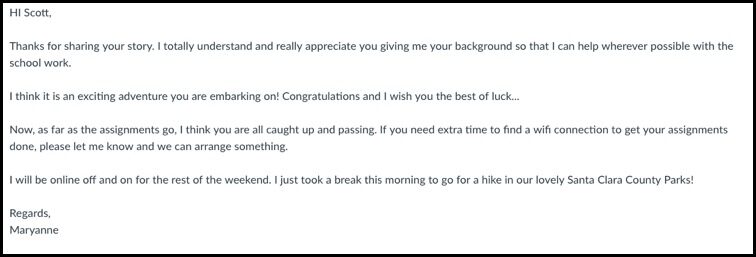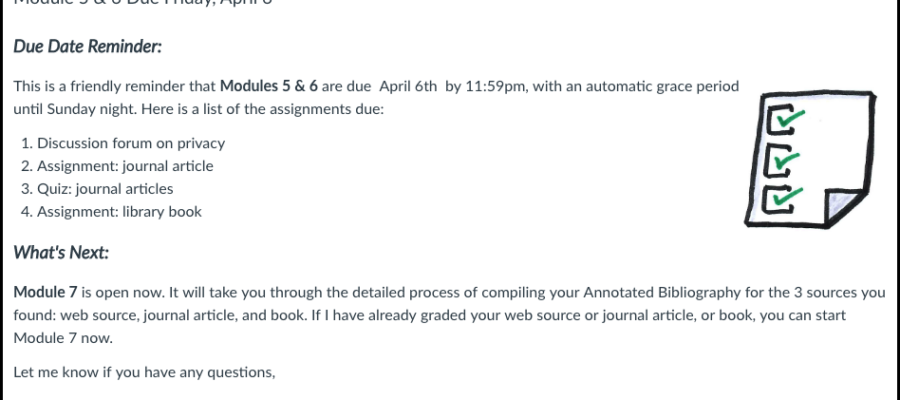What does it mean to be present in an online course?
So often we hear about students who feel isolated and unsure of how to proceed if they fall a bit behind, cannot afford the textbook, or don’t understand an assignment. Studies show that increasing alienation within a course contributes to lower online retention and persistence. Building a strong sense of community may be an antidote to these experiences, according to Rovai and Whiting.
In addition, research has shown that low-income and first-generation students are less likely to be engaged in the academic and social experiences that foster success in college, such as studying in groups, interacting with faculty and other students, participating in extracurricular activities, and using support services. (Engle, 2008, p. 3, emphasis added).
What can we do as instructors?
Effective online teachers can significantly overcome these issues by being mindfully present — making sure our students know we are there to help and support them throughout their college journey. Instructors do this by interacting with students one-on-one and by creating a community where social presence is fostered and the sharing of ideas is respected. In research conducted by the Community College Research Center at Columbia, a survey of 23 online community college classes showed that a course’s level of interpersonal interaction was the most important factor in predicting student grades.
Through course observations and interviews, Jaggers & Xu, the researchers in the above study, observed that frequent and effective student–instructor interaction created an online environment that encourages students to commit themselves to the course and perform stronger academically (2014, p. 2).
Online Presence: Some Examples
| 1. When you sit down and talk to students about their online experience, it can really be an eye-opener and a catalyst for change. Here is brief video describing an interview I had with student about her first online class. We came up with some takeaways for instructors. | 2. Giving personal feedback with audio and visual aids can really make a connection with a student. You are personally talking to them and that shows how much you care. Plus, this is a lot easier to create than writing your feedback. |
| 3. Create a brief welcome video and put it on your e-syllabus and on your faculty web page. Also, send it out to students a week before class to introduce yourself. | 4. Connecting new content through shared stories is a way to create community. Ask students to create Adobe Spark videos to share relevant examples of their lives. |
One-on-one interactions
In the slider below are examples of interactions I have had with my students. Sending the class weekly Announcements in Canvas is key to keeping students on track–especially in a short-term class. Also, initiating conversations and giving positive feedback helps to foster communication and trust. When students see that you care, they are apt to strive for excellence. Roll over the slider below to see the arrows to advance to the examples. Here is a PDF accessible version.
Reflections
Where I was
Robotic. Most of the content in my online classes were text-based with a few screen-casting videos and two discussion forums. I tried to “chunk” the content with bullet points, horizontal lines and Canvas indentation of  modules, but it left much to be desired. I did use Canvas Announcements every week, but I was also incorrectly posting new content on the Home page thinking that was the landing page for students. I realized only after I became a student with @One that the Home page was not the landing page.
modules, but it left much to be desired. I did use Canvas Announcements every week, but I was also incorrectly posting new content on the Home page thinking that was the landing page for students. I realized only after I became a student with @One that the Home page was not the landing page.
Where I am
Better instructor presence. I now regularly check on students’ activity in the class –if they miss an assignment, I ask them how they are doing and if I can help. I am also quick to point them to campus services including NetTutor and our online counseling services. I started using the voice memo option in Canvas when  giving feedback as well as encouragement. I also use Screencast-O-Matic to grade assignments and explain my feedback. It seems to make a huge difference in the way students accept feedback. My voice and tone can be heard and appreciated. It also take me less time to grade in this manner when compared to using grading editor in Canvas.
giving feedback as well as encouragement. I also use Screencast-O-Matic to grade assignments and explain my feedback. It seems to make a huge difference in the way students accept feedback. My voice and tone can be heard and appreciated. It also take me less time to grade in this manner when compared to using grading editor in Canvas.
Where I am headed
Enhancing my online social presence. In order to build a connected community online, I will start to use FlipGrid as a tool for students to introduce themselves as well as use it to give their opinions or share stories about something they learned  in class. I have created a Welcome Video embedded in my syllabus and my next step will be to create introductory videos for every module. I am also becoming more relaxed in my videos instead of being stilted and somber. I want to receive more student feedback. I will be implementing a Wisdom Wall for this exercise which I first learned about in Pacansky-Brock’s Best Practices for Teaching with Emerging Technologies.
in class. I have created a Welcome Video embedded in my syllabus and my next step will be to create introductory videos for every module. I am also becoming more relaxed in my videos instead of being stilted and somber. I want to receive more student feedback. I will be implementing a Wisdom Wall for this exercise which I first learned about in Pacansky-Brock’s Best Practices for Teaching with Emerging Technologies.
References and Attributions
Header image: “1. Online Presence” is a derivative from the original work by oo11o on Pixabay in the Public Domain, CC0
Community College Research Center at Columbia. (2013, April ). Creating an effective online instructor presence . Retrieved from https://www.achievingthedream.org/sites/default/files/resources/Online-Learning-Practitioner-Packet.pdf
Engle, J., & Pinto, V. (2008). Moving beyond access: College success for low-income, first-generation students. Pell Institute for the Study of Opportunity in Higher Education. https://files.eric.ed.gov/fulltext/ED504448.pdf
Jaggars, S.S. & Xu, D. (2014, February 12). Predicting online student outcomes from a measure of course quality. CCRC Working Paper No. 57. Retrieved from https://academiccommons.columbia.edu/doi/10.7916/D8N29TZH
Pacansky-Brock, M. (2017). Best practices for teaching with emerging technologies. (2nd ed.). New York, NY: Routledge.
Rovai, A.P. & Wighting, M.J. (2005). Feelings of alienation and community among higher education students in a virtual classroom. Internet and Higher Education, 8 97 – 110. Retrieved from https://bit.ly/3rOTXzW






